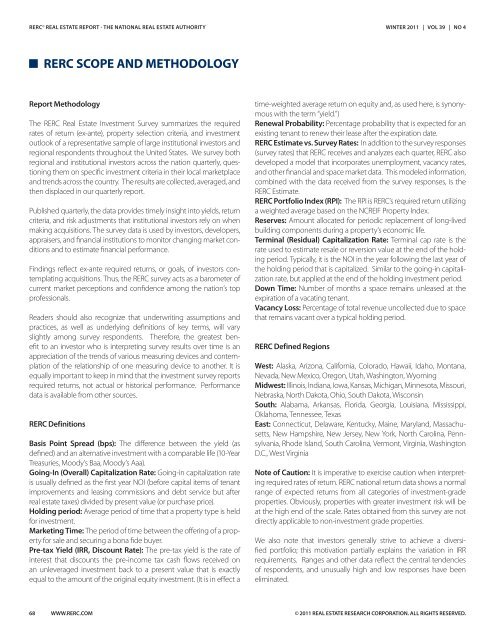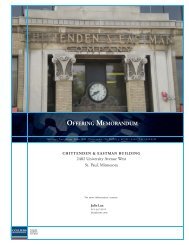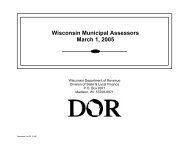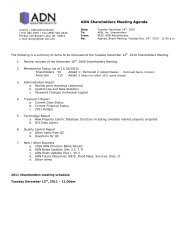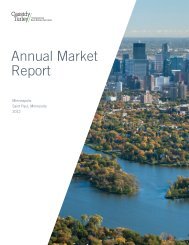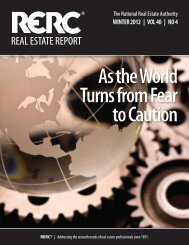REAL ESTATE REPORT - REDI-net.com
REAL ESTATE REPORT - REDI-net.com
REAL ESTATE REPORT - REDI-net.com
- TAGS
- real
- estate
- redi-net.com
Create successful ePaper yourself
Turn your PDF publications into a flip-book with our unique Google optimized e-Paper software.
RERC © <strong>REAL</strong> <strong>ESTATE</strong> <strong>REPORT</strong> - THE NATIONAL <strong>REAL</strong> <strong>ESTATE</strong> AUTHORITY<br />
RERC SCOPE AND METHODOLOGY<br />
Report Methodology<br />
The RERC Real Estate Investment Survey summarizes the required<br />
rates of return (ex-ante), property selection criteria, and investment<br />
outlook of a representative sample of large institutional investors and<br />
regional respondents throughout the United States. We survey both<br />
regional and institutional investors across the nation quarterly, questioning<br />
them on specific investment criteria in their local marketplace<br />
and trends across the country. The results are collected, averaged, and<br />
then displaced in our quarterly report.<br />
Published quarterly, the data provides timely insight into yields, return<br />
criteria, and risk adjustments that institutional investors rely on when<br />
making acquisitions. The survey data is used by investors, developers,<br />
appraisers, and financial institutions to monitor changing market conditions<br />
and to estimate financial performance.<br />
Findings reflect ex-ante required returns, or goals, of investors contemplating<br />
acquisitions. Thus, the RERC survey acts as a barometer of<br />
current market perceptions and confidence among the nation’s top<br />
professionals.<br />
Readers should also recognize that underwriting assumptions and<br />
practices, as well as underlying definitions of key terms, will vary<br />
slightly among survey respondents. Therefore, the greatest benefit<br />
to an investor who is interpreting survey results over time is an<br />
appreciation of the trends of various measuring devices and contemplation<br />
of the relationship of one measuring device to another. It is<br />
equally important to keep in mind that the investment survey reports<br />
required returns, not actual or historical performance. Performance<br />
data is available from other sources.<br />
RERC Definitions<br />
Basis Point Spread (bps): The difference between the yield (as<br />
defined) and an alternative investment with a <strong>com</strong>parable life (10-Year<br />
Treasuries, Moody’s Baa, Moody’s Aaa).<br />
Going-In (Overall) Capitalization Rate: Going-in capitalization rate<br />
is usually defined as the first year NOI (before capital items of tenant<br />
improvements and leasing <strong>com</strong>missions and debt service but after<br />
real estate taxes) divided by present value (or purchase price).<br />
Holding period: Average period of time that a property type is held<br />
for investment.<br />
Marketing Time: The period of time between the offering of a property<br />
for sale and securing a bona fide buyer.<br />
Pre-tax Yield (IRR, Discount Rate): The pre-tax yield is the rate of<br />
interest that discounts the pre-in<strong>com</strong>e tax cash flows received on<br />
an unleveraged investment back to a present value that is exactly<br />
equal to the amount of the original equity investment. (It is in effect a<br />
68 WWW.RERC.COM<br />
WINTER 2011 | VOL 39 | NO 4<br />
time-weighted average return on equity and, as used here, is synonymous<br />
with the term “yield.”)<br />
Renewal Probability: Percentage probability that is expected for an<br />
existing tenant to renew their lease after the expiration date.<br />
RERC Estimate vs. Survey Rates: In addition to the survey responses<br />
(survey rates) that RERC receives and analyzes each quarter, RERC also<br />
developed a model that incorporates unemployment, vacancy rates,<br />
and other financial and space market data. This modeled information,<br />
<strong>com</strong>bined with the data received from the survey responses, is the<br />
RERC Estimate.<br />
RERC Portfolio Index (RPI): The RPI is RERC’s required return utilizing<br />
a weighted average based on the NCREIF Property Index.<br />
Reserves: Amount allocated for periodic replacement of long-lived<br />
building <strong>com</strong>ponents during a property’s economic life.<br />
Terminal (Residual) Capitalization Rate: Terminal cap rate is the<br />
rate used to estimate resale or reversion value at the end of the holding<br />
period. Typically, it is the NOI in the year following the last year of<br />
the holding period that is capitalized. Similar to the going-in capitalization<br />
rate, but applied at the end of the holding investment period.<br />
Down Time: Number of months a space remains unleased at the<br />
expiration of a vacating tenant.<br />
Vacancy Loss: Percentage of total revenue uncollected due to space<br />
that remains vacant over a typical holding period.<br />
RERC Defined Regions<br />
West: Alaska, Arizona, California, Colorado, Hawaii, Idaho, Montana,<br />
Nevada, New Mexico, Oregon, Utah, Washington, Wyoming<br />
Midwest: Illinois, Indiana, Iowa, Kansas, Michigan, Minnesota, Missouri,<br />
Nebraska, North Dakota, Ohio, South Dakota, Wisconsin<br />
South: Alabama, Arkansas, Florida, Georgia, Louisiana, Mississippi,<br />
Oklahoma, Tennessee, Texas<br />
East: Connecticut, Delaware, Kentucky, Maine, Maryland, Massachusetts,<br />
New Hampshire, New Jersey, New York, North Carolina, Pennsylvania,<br />
Rhode Island, South Carolina, Vermont, Virginia, Washington<br />
D.C., West Virginia<br />
Note of Caution: It is imperative to exercise caution when interpreting<br />
required rates of return. RERC national return data shows a normal<br />
range of expected returns from all categories of investment-grade<br />
properties. Obviously, properties with greater investment risk will be<br />
at the high end of the scale. Rates obtained from this survey are not<br />
directly applicable to non-investment grade properties.<br />
We also note that investors generally strive to achieve a diversified<br />
portfolio; this motivation partially explains the variation in IRR<br />
requirements. Ranges and other data reflect the central tendencies<br />
of respondents, and unusually high and low responses have been<br />
eliminated.<br />
© 2011 <strong>REAL</strong> <strong>ESTATE</strong> RESEARCH CORPORATION. ALL RIGHTS RESERVED.


